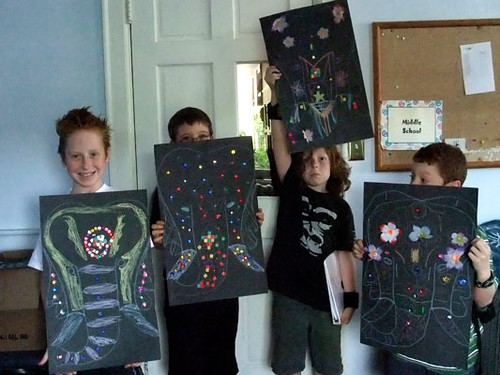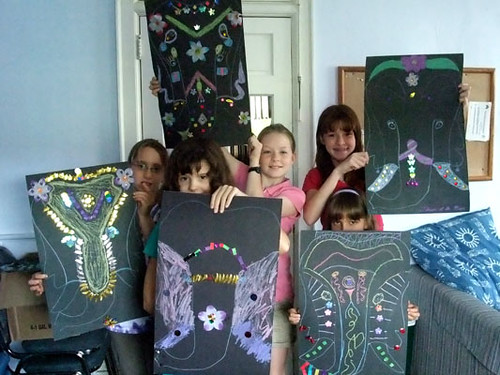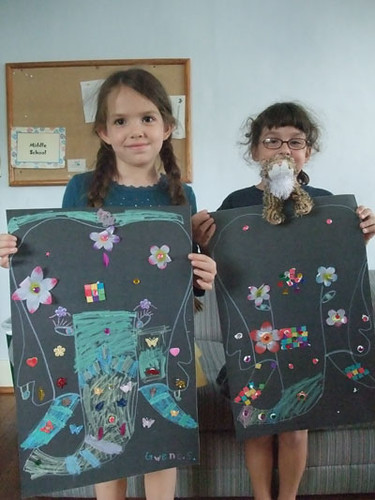
Namaste.
Today to warm up, we practiced our Johar greeting. We're getting fast, but I know we can be faster. I attribute our slowness to extreme giggling caused by people calling each other the wrong name. Which never fails to amuse.
Quiz:
1. Hindus believe in one god, which means they are polytheists.
2. The Greeks had a pantheon, the Romans had a pantheon, and the Hindus have a pantheon.
3. A trinity is a type of drink popular in Goa, a coastal city of Southern India.
4. Brahma is the creator, Ganesha is the preserver, and Zeus is the destroyer.
5. Even though there are many gods in the pantheon, many Hindus believe they are all different manifestations of the same idea of god.
6. An avatar is a divine incarnation, which means a part of god that appears on earth.
7. Devas are people who think they are very important to a religion, and act bossy and rude, mostly found in New York and Los Angeles.
8. Ganesha, the elephant-headed god of overcoming obstacles, is one of the most popular gods in the pantheon.
9. Mother goddesses are important to Hindus. Some major ones are Lakshmi, Parvati, and Kali.
10. There is only one version of Hindu. Anyone practicing a variation has to be reincarnated as a pickle.
If you want the answers, ask your child. I'll give you a hint: The pickle one is FALSE.
Songs: After the quiz, we sang our songs, "If," "Mandalay," and "Jungle Book TV Theme." The enrichment class boogied like it was their job.
The White Seal: We had three teaching points today.
1. Point of view. The White Seal is in the point of view of the animals again, like Rikki Tikki Tavi. I asked the children why Kipling chose to write from this perspective, and we talked about how the story illuminates this secret world of seals, which could never have been narrated from the perspective of humans. I introduced the idea that will become much more important later in the Mowgli stories, that Kipling adds layers of law and order over a "society" that is generally seen as lawless and therefore inferior. So where we see a bunch of unruly seals rolling around on the beach, Kipling sees these rich relationships full of culture and tradition. This will relate later to imperialist attitudes toward native populations.
I asked the kids whether the Aleuts who killed the seals were wrong to do it. They all said yes. Then I asked them to imagine the same scene told from the perspective of the humans. For the younger class, I started to tell a story about a boy living in the harsh environment of this Alaskan island, fighting for survival, trying to get clothes, blankets, and tents for his family, oil to burn in their lamps, food to eat, life from these seals. Would that boy be wrong to kill seals to save his family? So, it gets murky. One child asked, "Why can't they just kill and eat the fish?" I asked if they could imagine a story told from the point of view of fish, that would make a reader think that killing fish was wrong. They said no, but I pointed out Finding Nemo and reminded them of the scene at the end with the fishing boat and the "Swim down together!" They started to get my point!
2. The power of fiction. The lesson of The White Seal is not so much about seals and Aleuts and saving your people and arctic adventure and more about how fiction works to make us *feel* about an issue, rather than thinking about it. I asked the children to tell me how the seal killing made them feel: sad, bad, worried, afraid, etc. Creating feelings in a reader by telling the story of a character the reader cares about can be a much more direct route to a reader's opinion than a non-fiction essay that invites argument. We talked about different works of fiction that were written to make a point, and one child brought up Misty of Chincoteague, which is a great example of changing readers' minds with fiction on a massive scale that could never be accomplished (in my opinion) without a character and a narrative.
3. Is killing seals wrong? We talked around the question for a while, and different children talked about their different levels of vegetarianism or veganism. For me, as usual, it's less about the issue and more about the literary artifice, and teaching the children how changing the point of view can radically affect the story's message, and how authors make these decisions based on what they want to make the reader feel. Identifying and evaluating the point of view is one of the first steps in becoming a conscious reader. Have you guessed that our next story is about seal hunting from the point of view of an Aleutian boy?
New Song: We learned "Lukannon," which Kipling says is the seal national anthem. It's a sad, angry song... this will be the last poem we memorize this semester.
Assignment: The fast facts for this week are all over a map of the world. I made a map of ten of the places Kotick travelled in his search for the island without men. On the map your child brought home, you'll see ten locations labelled, which we went over in class. Next week's quiz will be a blank map, and they'll fill in the numbers for me. The reading assignment for next week is "Quiquern."
Links:
A map of the Aleutian Islands.
A cool volcano in the Aleutian Islands.
A picture of Aleut clothing.
Aleuts in a kayak hunting whale.
Dog sled pictures: 1. 2. 3.









